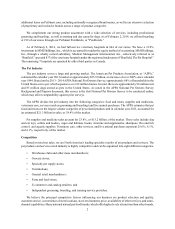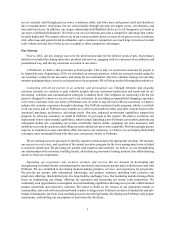Petsmart 2013 Annual Report Download - page 20
Download and view the complete annual report
Please find page 20 of the 2013 Petsmart annual report below. You can navigate through the pages in the report by either clicking on the pages listed below, or by using the keyword search tool below to find specific information within the annual report.12
Our quarterly operating results may fluctuate due to seasonal changes associated with the pet products and
services retail industry and the timing of expenses, new store openings, and store closures.
Our business is subject to seasonal fluctuation. We typically realize a higher portion of net sales and operating
profits during our fourth quarter, as compared to our other quarters, due to increased holiday traffic. As a result of
this seasonality, we believe that quarter-to-quarter comparisons of our operating results are not necessarily
meaningful and that these comparisons cannot be relied upon as indicators of future performance. Because our
stores typically draw customers from a large trade area, sales also may be impacted by adverse weather or travel
conditions, which are more prevalent during certain seasons of the year. As a result of our expansion plans, the
timing of new store and PetsHotel openings and related preopening costs, the amount of revenue contributed by
new and existing stores and PetsHotels, and the timing and estimated obligations of store closures, our quarterly
results of operations may fluctuate. Controllable expenses could fluctuate from quarter-to-quarter in a year. Finally,
because new stores tend to experience higher payroll, advertising, and other store-level expenses as a percentage
of net sales than mature stores, new store openings also contribute to lower store operating margins until these
stores become established.
A disruption, malfunction, or increased costs in the operation, expansion, or replenishment of our distribution
centers or our supply chain could impact our ability to manage our inventory, deliver products to our stores, or
increase our expenses, which could harm our sales and results of operations.
Our vendors generally ship merchandise to our distribution centers, which then allocate the merchandise to
our stores. Any interruption or malfunction in our distribution operations, including, but not limited to, disruptions
to the transportation infrastructure, disruptions caused by weather, catastrophic events, disease, contamination, or
trade barriers, the loss of a key vendor that provides transportation of merchandise to or from our distribution
centers, the failure of a key vendor to deliver on its commitments, or a material increase in our transportation and
distribution costs, including, but not limited to, costs resulting from increases in the price of fuel and other energy
costs or other commodities, could harm our sales and results of operations.
We seek to optimize inventory levels to operate our business successfully. Nonetheless, we are exposed to
inventory risks that may adversely affect our operating results as a result of seasonality, new product launches,
vendor reliability, changes in customer preferences or demand, and changes in consumer spending patterns with
respect to our products. We endeavor to accurately predict these trends and avoid over or under stocking products
that we sell. Demand for products, however, can change between the time inventory is ordered and the date of sale
and we may be unable to accurately forecast such changes. Any of the events above could result in out-of-stock
or excess merchandise inventory levels that could harm our sales and the results of operations.
We operate five fish distribution centers and have one fish distribution center that is operated by a third-party
vendor. An interruption or malfunction in these operations or in the fulfillment of fish orders could harm our sales
and results of operations. Operating the fish distribution centers is a very complex process, and if we lose the third-
party operator, we can make no assurances that we could contract with another third party to operate the fish
distribution center on favorable terms, if at all, or that we could successfully operate all of the fish distribution
centers ourselves. In addition, our growth plans require the development of new distribution centers to service the
increasing number of stores. If we are unable to successfully expand our distribution network in a timely manner,
our sales or results of operations could be harmed.
If our information systems fail to perform as designed or are interrupted for a significant period of time, our
business could be harmed.
The efficient operation of our business is dependent on our information systems. In particular, we rely on our
information systems to effectively manage our financial and operational data, process payroll, manage the supply
chain, and maintain our in-stock positions. We possess disaster recovery capabilities for our key information
systems, and take measures intended to prevent security breaches and computer viruses. However, the failure of
our information systems to perform as designed, due to failure to manage disasters, security breaches, computer
























